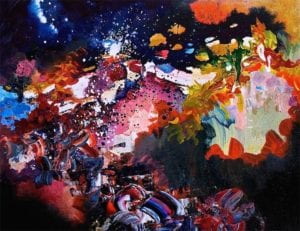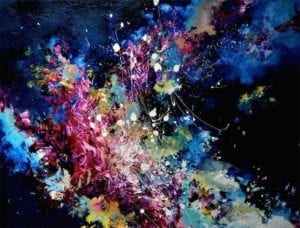The choice of art I have chosen to discuss for this reading response comes from Melissa McCracken’s collection of synesthesia paintings, in which she translates her reactions to music and sound into art through the usage of oil paints, brushes, and a canvas. She has created various pieces, ranging from genres of pop, classical and her ultimate favorite, jazz. Stemming from her frustration in having to constantly explain the perceptual phenomenon generated through her united senses, McCracken turned to the visual arts to aid her in expressing this sense of ‘colored hearing.’ (As delineated within this week’s reading of “Synesthesia, A Neurological Phenomenon” written by Hinderk M. Emrich, Janina Neufeld, and Christopher Sinke) Through this colored hearing in the realm of genuine synesthesia, McCracken’s mind “automatically and involuntarily” (418) perceives spoken words, letters and or sounds through visual representations like “colors and/or figures, so-called photisms” (415). This rare neurological condition, which as the Kansas-based synesthete states, occurs through the cross-wiring of the brain that causes certain stimuli to create unique responses to everyday things. Apart from McCracken, there are only a few other artists exercising their shared ability through the outlet of visual art.




I believe that this form of visual output is crucial to both the art world and the scientific universe. As mentioned in the article as well as Jamie Ward and Samantha Moore’s research through Synaesthesia and Sound, visualized synaesthetic photisms are frequently “perceived as particularly aesthetic even by non-synesthetes” (415). They bring vibrant pieces of illustration, cross-wiring of colors and transformation techniques to the genre, all while carrying a unique sense of personal taste and commitment. It’s as if inviting the spectator into the literal mind of the synesthete artist. On other terms, the visualization of genuine synesthesia not only raises interest in non-synesthetes regarding the existence of such phenomenons but also brings scientists and researchers margins closer to understanding the condition as a whole. Furthermore, with its relation to the human brain’s functionality, the artistic output of McCracken and several other synesthete artists provide the curious with much-needed intuition into human perception.